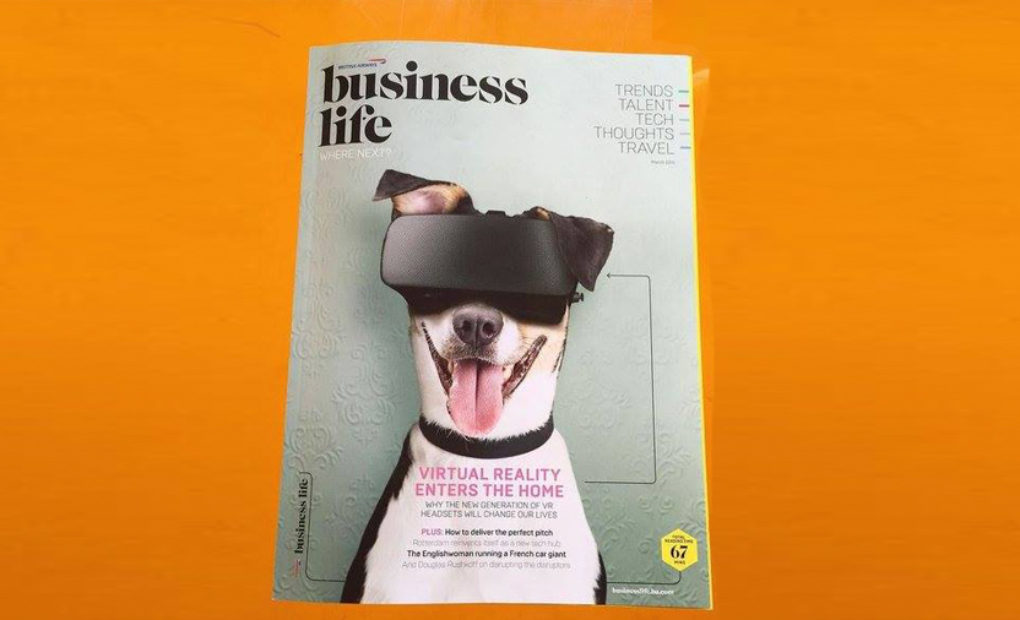
Virtual Reality Enters the Home – we spoke to BA Business Life
A new generation of headsets, beginning with the Oculus Rift, is about to bring virtual reality into our homes. Report by Tim Hulse
Wade Watts pulls on his elastic haptic gloves, flexes his fingers and grabs his console. Then he slips on a visor that fits snugly around his eyes, blocking out the light. Small earbuds connected to the visor automatically plug themselves into his ears. Wade powers on the console and initiates the log-in sequence.
In the real world, the ice caps are melting, plants and animals are dying off, there is a global energy crisis and wars are being fought. But Wade is about to escape to another place. It’s a virtual place that seems just as real as the one he is leaving, but it’s one where he has a different name and a different appearance. It contains a multitude of different worlds that can be reached by teleportation and it’s a place where pretty much anything is possible…
This is the pretext for Ernest Cline’s novel Ready Player One, first published in 2011 and currently being turned into a movie directed by Steven Spielberg. Cline set the book in the year 2044, but already the concept of an era in which we escape the everyday world and spend our time in a virtual reality ‘metaverse’ is looking closer than we could have imagined even five years ago.
At the end of this month, the launch of the new Oculus Rift headset will provide a significant boost for the mushrooming VR industry. Goldman Sachs recently predicted that the combined virtual and augmented reality market could be worth more than $80bn in less than ten years from now. “It’s really going to change many aspects of our life and be completely disruptive,” according to analyst Heather Bellini.
As well as hardware, companies are busy cooking up a host of games and virtual experiences. “This is the beginning of an explosion of content,” says Mike Rothenberg, who runs a venture capital firm focused on virtual reality. “This is the first innings. Everything else has just been warm up.”
And it has to be said it’s been a long, drawn out warm up. Despite appearances to the contrary, virtual reality is nothing new. The first VR head-mounted display (HMD) system was invented back in 1968 by American computer scientist Ivan Sutherland. It was so heavy that it had to be suspended from the ceiling, earning it the nickname The Sword of Damocles. By the 1990s many companies, including Sega and Nintendo, were attempting to commercialise VR, but with limited success. It seemed that the world of The Matrix would remain restricted forever to Hollywood movies.
It has taken a laid-back, sandal-wearing Californian wunderkind to change all that. Palmer Luckey became so obsessed with the idea of VR that he collected HMDs from an early age, ending up with more than 50 different examples. Seeing their limitations, he created his own headset, aged just 18, in his parents’ garage. Over the following months, he created a series of prototypes. The sixth and final one was called the Rift and in 2012 he decided to sell it as a $300 kit for fellow VR fans as part of a Kickstarter crowdfunding campaign. He formed a company, Oculus VR, to make it happen.
What happened next was unexpected. The Kickstarter campaign went on to raise $2.4m — more than 900 per cent of its original target. And in March 2014, Facebook acquired Oculus for $2bn. Which was good news for Luckey, whose personal wealth has since been estimated at $700m. More importantly, he had set the new VR revolution running. Suddenly it seemed that VR was a practical proposition after all…
“I ordered one of the Kickstarter kits and it just blew our minds completely,” says Henry Stuart, the CEO and co-founder of London-based VR specialist Visualise. Until that point, Stuart had worked in 360° photography and had just begun working with 360° video. “The Oculus Rift totally blew the door off the whole industry. It opened everything up,” he remembers. “We started to visit all the various digital agencies in London and any brands we could get access to, and everyone was going crazy for it. You put somebody in that headset and you got a similar reaction as you do today when you put it on someone who’s not tried it. It sells itself. So we then started growing our work from there and all the other work we used to do has just fallen by the wayside.”
Continue reading over on the BA Business Life site.

Comments